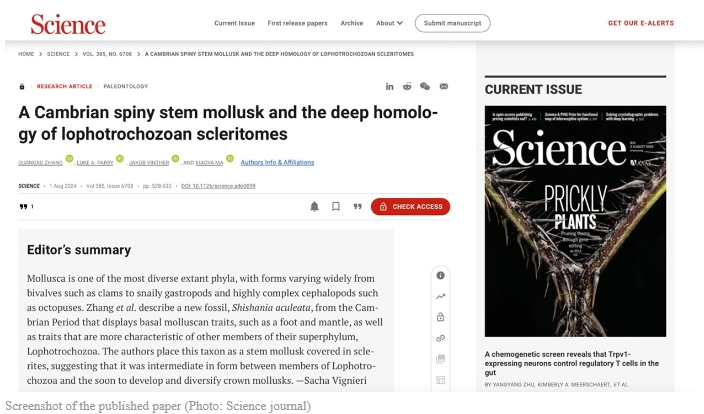Kunming, China — Scientists from Southwest China’s Yunnan Province have made a groundbreaking discovery, revealing new insights into the origins and early evolution of mollusks. Published in the journal Science on Friday, the study uncovers the origins of Shishania aculeata, a species of mollusk that lived 514 million years ago during the Cambrian Period.
The initial discovery of the Shishania aculeata fossils was made by Zhang Guangxu, a doctoral graduate from Yunnan University, in March 2019 in Fumin County, Yunnan. Through detailed analysis, the research team identified these fossils as rare mollusks with well-preserved soft carapaces, an exceptional find given their age.
The study describes Shishania aculeata as a shell-less mollusk with unique characteristics such as conical, hollow chitinous sclerites, a smooth girdle, broad feet, and a mantle cavity. The sclerites exhibited a microstructure of narrow canals, which bear similarities to the chaetal microvilli seen in annelids and brachiopods, suggesting a possible shared origin of these structures among different lophotrochozoans.
Advanced imaging and analysis techniques allowed the researchers to examine the internal structure of Shishania aculeata, revealing growth patterns akin to those of annelids. This discovery implies that the hard structures in various lophotrochozoans may share a common evolutionary origin.
Ma Xiaoya, a co-author of the paper and a researcher at the Institute of Palaeontology, Yunnan University, emphasized that the well-preserved anatomical details of Shishania aculeata offer significant insights into the early evolutionary stages of mollusks. The ongoing research is expected to further illuminate the origins and diversification of mollusks during the Cambrian explosion.
The study underscores the importance of Cambrian fossil sites in Yunnan, which continue to provide exceptional specimens that enhance our understanding of early animal evolution. This discovery not only contributes to the scientific knowledge of mollusk evolution but also highlights the rapid diversification that occurred during the Cambrian Period.

